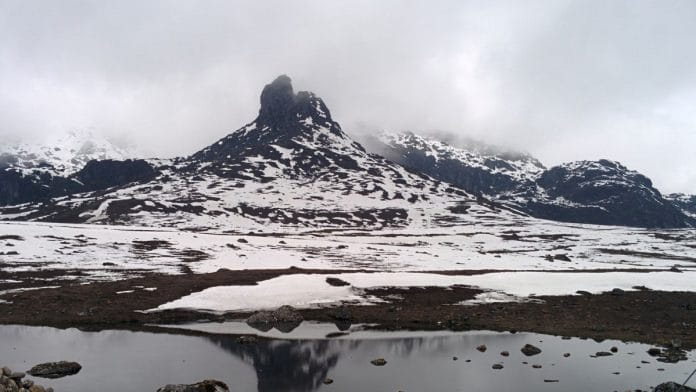New Delhi: The pristine, snow-covered Himalayas in Arunachal Pradesh are facing an existential threat in the form of rapid glacial decline, and a group of scientists from Nagaland University and Assam’s Cotton University has documented this.
Using data from 32 years, the scientists meticulously studied the change and decline in the number and area of glaciers in Arunachal. They found that from covering 585 square kilometres in 1988, the total glacier area in the state had shrunk to only 275 square kilometres by 2020. This means there was an almost 53 percent decline in the total glacier area.
The study describing the findings was published last month in the Journal of Earth System Science.
“Glaciers are one of the best proxies for climate change and its acute impact,” Dr Nabajit Hazarika, assistant professor at the department of environmental biology and wildlife sciences, Cotton University, Guwahati, and one of the authors of the study, told ThePrint. “And we saw it happen in real time—how global warming has led to more glaciers melting in the Eastern Himalayas.”
Using satellite data from NASA’s Landsat programme, the researchers mapped glaciers in regions like Tawang, West Kameng, Upper Siang, and Upper Dibang Valley in Arunachal Pradesh. This is the first-ever study to examine glacier melting across the entire state of Arunachal Pradesh. Usually, studies in the Eastern Himalayas are restricted to specific basins or regions.
“It was also important for us to study it for at least 30 years because that is the minimum amount of time for weather patterns to be considered ‘climate’,” explained Latonglila Jamir, associate professor at Nagaland University, and a co-author of the study. “To be able to compare our data to temperature or rainfall, we need to observe it for long enough.”
Melting glaciers lead to one major phenomenon—the formation of glacial lakes. These are natural features formed when runoff from melting glaciers settles into rock crevices. More glacial lakes increase the likelihood of glacial lake outburst floods (GLOFs) simply as a matter of probability. India, and the Eastern Himalayas in particular, witnessed a devastating GLOF event just two years ago in Sikkim.
Hazarika, along with his colleagues Latonglila Jamir and Vimha Ritse from Nagaland University, found that there were a total of 756 glaciers covering almost 585.23 square kilometres in 1988, across northern, eastern, and western Arunachal Pradesh. By 2020, the number of glaciers had decreased to 646, and the area they covered had dwindled significantly to 275.381 square kilometres.
“The Eastern Himalayas are at a lower elevation than the Western Himalayas, so they might experience the effects of global warming more,” said Dr Jamir. “As temperatures increase, we will see the effects in the retreat of more glaciers and the formation of more glacial lakes.”
Why the Eastern Himalayas?
Melting glaciers have long been recognised as one of the most significant consequences of climate change, but Hazarika and his colleagues at Nagaland University were particularly interested in conducting the study in their neighbouring environment.
The Eastern Himalayas, unlike their Western counterparts in Uttarakhand and Himachal Pradesh, do not receive as much attention and have not been well documented by scientists. It is not just glacial decline but the entire cryosphere (frozen water part of the Earth system) of the almost 2,500-kilometre region that remains largely unexplored.
“There are many reasons—the terrain is literally impenetrable, so there are very few on-ground research stations and, therefore, not much field research has been conducted here,” said Dr Hazarika.
When the scientists completed their research, they found that the number of glaciers in Arunachal Pradesh fluctuated between 1988 and 2020. In 2005, there were 726 glaciers, which decreased to 697 in 2010. In 2015, the number increased again to 714 before dropping to 646 in 2020. Jamir has an explanation for this.
“Sometimes, when a glacier is melting, it might split and become two. That does not mean you had one glacier and now you have two, so it is a good thing—the glacier is still retreating,” she said. “It is the overall area covered that matters.”
Now, the same team of researchers from Cotton University and Nagaland University is working on a new paper on the Tawang region, an important tourist and religious attraction that also has many glaciers. The scientists are conducting a case study to understand how the ice and snow in the region have changed over the past few years.
“Glacial melting affects water availability in a region, overall climate patterns, and climate-related risks. We are simply trying to document these effects in our area—the Eastern Himalayas,” said Dr Hazarika.
(Edited by Radifah Kabir)
Also Read: Search for an Indian Carl Sagan is on. Science influencers are being trained in labs and likes






